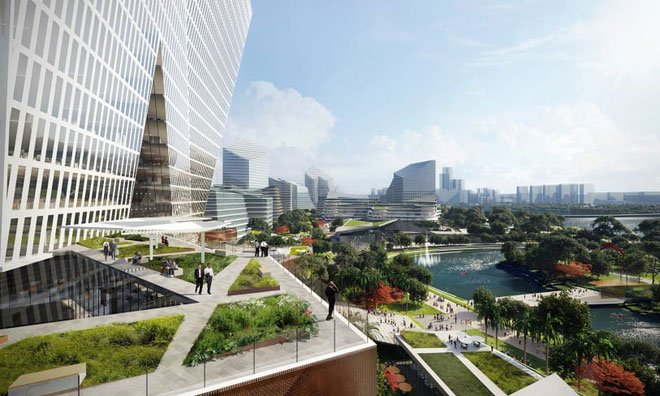Tencent's 'future city' project: 2km2 wide, no cars, taking advantage of self-driving vehicles
Tencent aspires to close the gap between work and personal life.
Technology giant Tencent has just announced plans to build a 'future city' , an urban area of up to 2km 2 and almost no cars. Called Net City , the city's traffic element will revolve around walking paths, interconnected green parks and self-driving cars. Net City will be located right inside Shenzhen city.

Net City, the future city of Tencent.
Designed to accommodate up to 80,000 people, Net City will also be the headquarters of the giant Tencent group, the giant behind WeChat, QQ, Riot Games and Epic Games. In addition to providing residences and workplaces for Tencent employees, Net City will also include hospitals, schools, shops and other public facilities. Net City is also connected to the rest of Shenzhen via roads, ferries to the river and the subway system. Inside Net City will also be a number of tourist attractions such as water parks, amusement parks .

Designers try to eliminate cars from life in Net City.
NBBJ, an American design and construction company, created Net City, creating the solution to eliminate most of all four-wheel vehicles in the city.
' Our main goal is to create an area that allows the new to be developed. To do that, we try to limit the impact of cars to the lowest possible level , '' said Jonathan Ward, a design expert who collaborated with NBBJ.
Cars can still access and exit parts of the city, but the main way of transportation for Net City residents will be alternating green boulevards, designed for buses, bicycles and self-propelled vehicles. This will eliminate a large amount of urban transportation.
' People don't need a building surrounded by roads, they will have eight buildings with a single main road running across, and we will eliminate all other side roads, ' says Ward. to speak. ' We have cut a lot of the roads, mainly in places that allow people to take a 2-minute walk to reach the train station or a taxi stop .'
' And within those two minutes of walking, you can see something inspiring, connecting your soul with nature or meeting a long-term colleague who doesn't meet - all that can happen in a work environment. will appear in our city . '

Net City will remain open to the public, not a special zone of Tencent.
In addition to the plan to connect Net City with the rest of Shenzhen in a harmonious way, NBBJ also creates an 'organic ecosystem, involving multiple areas, focusing on the human element '. For Tencent employees, this means blurring the gap between work and personal life, which was clearly visible during the Covid-19 era.
On the roofs of Net City will be large solar systems and a pipeline that takes full advantage of rainwater. NBBJ's design experts also consider sea level rise to ensure Net City is safe from climate change.

It is expected that this city will be completed in 4 years, and will start construction within this year. Inside Net City will be a number of buildings designed by many other parties.
Tencent is not the only company raising its ambition to build its employees a tiny city. Earlier this year, Toyota announced plans for Woven City, a city of 708,000 square meters at the foot of Mount Fuji, that will be both a residence and a test site for Toyota's autonomous technology (including self-driving cars, helper robots and other IoT technologies).

Drawing Textile City of Toyota.
- Self-driving cars, the future of world cars is developing like?
- Learn the technology of self-driving cars
- US deploys self-driving cars
- MIT researchers found a way to drive cars to the countryside by themselves
- 7 fascinating technologies on future cars
- Who will self-drive cars choose to stab, avoid whom?
- Self-driving cars turn into mini beds and offices
- Launched the world's first commercial self-driving car
- Cars drive themselves in a ghost city
- Future cars will increase / decrease speed when passengers are uncomfortable
- America built a city for unmanned vehicles
- Google announced the historic turning point of self-driving cars
 'Fine laughs' - Scary and painful torture in ancient times
'Fine laughs' - Scary and painful torture in ancient times The sequence of numbers 142857 of the Egyptian pyramids is known as the strangest number in the world - Why?
The sequence of numbers 142857 of the Egyptian pyramids is known as the strangest number in the world - Why? History of the iron
History of the iron What is alum?
What is alum? The Great Underground Constructions of the Ancient World
The Great Underground Constructions of the Ancient World  Ho Chi Minh City is among the top 5 fastest sinking cities in the world.
Ho Chi Minh City is among the top 5 fastest sinking cities in the world.  Returning from the White City, the expedition team contracted a terrifying disease.
Returning from the White City, the expedition team contracted a terrifying disease.  What secrets do the Inca ruins of Machu Picchu hold?
What secrets do the Inca ruins of Machu Picchu hold?  Ho Chi Minh City will test 100km/h unmanned flying vehicle
Ho Chi Minh City will test 100km/h unmanned flying vehicle  Nearly 6,700 Maya 'ghosts' revealed in Mexico
Nearly 6,700 Maya 'ghosts' revealed in Mexico 